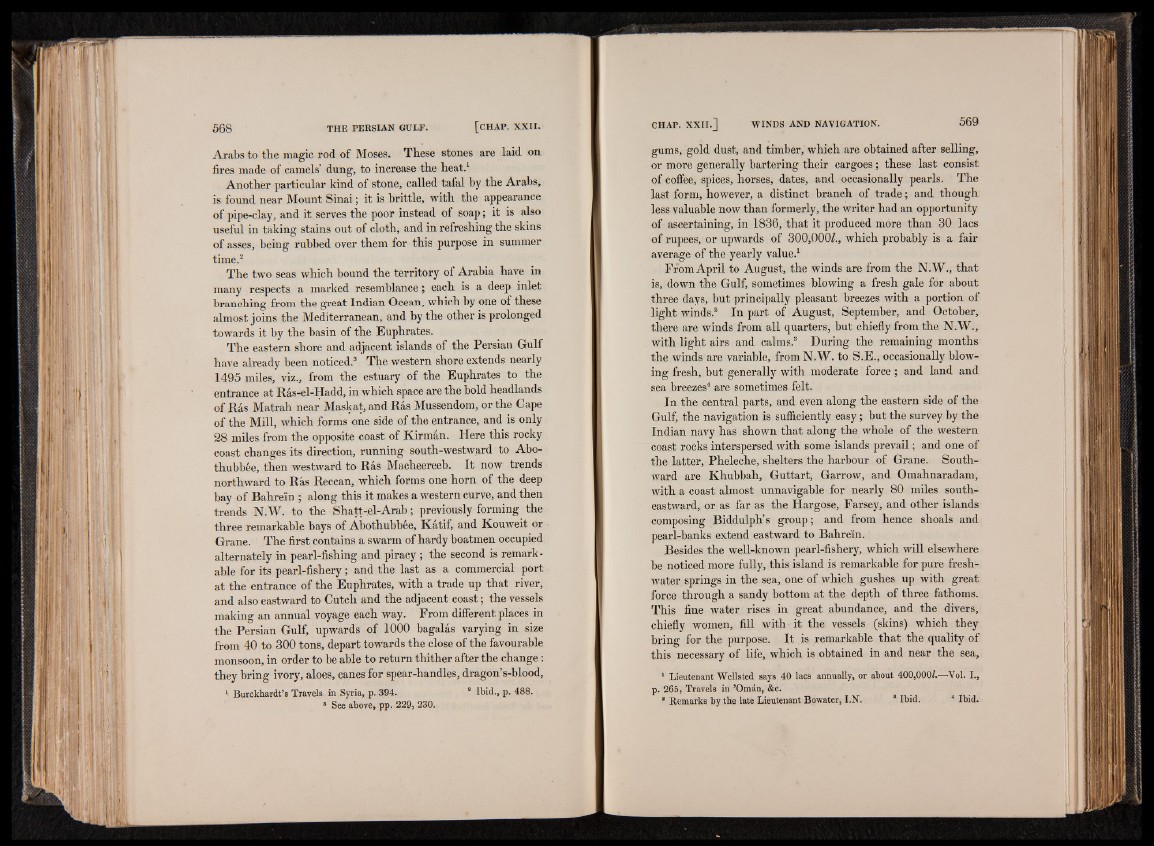
Arabs to tlie magic rod of Moses. These stones are laid on
fires made of camels’ dung, to increase the heat.1
Another particular kind of stone, called tafal by the Arabs,
is found near Mount Sinai; it is brittle, with the appearance
of pipe-clay, and it serves the poor instead of soap; it is also
useful in taking stains out of cloth, and in. refreshing the skins
of asses, being rubbed over them for this purpose in summer
time.2
The two seas which bound the territory of Arabia have in
many respects a marked resemblance; each is a deep inlet
branching from the great Indian Ocean, which by one of these
almost joins the Mediterranean, and by the other is prolonged
towards it by the basin of the Euphrates.
The eastern shore and adjacent islands of the Persian Gulf
have already been noticed.3 The western shore extends nearly
1495 miles, viz., from the estuary of the Euphrates to the
entrance at Ras-el-Hadd, in which space are the bold headlands
of Ras Matrah near Maskat, and Ras Mussendom, or the Cape
of the Mill, which forms one side of the entrance, and is only
28 miles from the opposite coast of Kirman. Here this rocky
coast changes its direction, running south-westward to Abo-
thubbee, then westward to Ras Macheereeb. It now trends
northward to Ras Reccan, which forms one horn of the deep
bay of Bahrein ; along this it makes a western curve, and then
trends N.W. to the Shatt-el-Arab; previously forming the
three remarkable bays of Abothubbee, Katif, and Kouweit or
Grane. The first contains a swarm of hardy boatmen occupied
alternately in pearl-fishing and piracy ; the second is remarkable
for its pearl-fishery; and the last as a commercial port
at the entrance of the Euphrates, with a trade up that river,
and also eastward to Cutcli and the adjacent coast; the vessels
making an annual voyage each way. From different places in
the Persian Gulf, upwards of 1Q00 bagalas varying in size
from 40 to 300 tons, depart towards the close of the favourable
monsoon, in order to be able to return thither after the change:
they bring ivory, aloes, canes for spear-handles, dragon’s-blood,
gums, gold dust, and timber, which are obtained after selling,
or more generally bartering their cargoes; these last consist
of coffee, spices, horses, dates, and occasionally pearls. The
last form, however, a distinct branch of trade.; and though
less valuable now than formerly, the writer had an opportunity
of ascertaining, in 1836, that it produced more than 30 lacs
of rupees, or upwards of 300,000£, which probably is a fair
average of the yearly value.1
From April to August, the winds are from the N.W., that
is, down the Gulf, sometimes blowing a fresh gale for about
three days, but principally pleasant breezes with a portion of
light winds.2 In part of August, September, and October,
there are winds from all quarters, but chiefly from the N.W.,
with light airs and calms.3 During the remaining months
the winds are variable, from N.W. to S.E., occasionally blowing
fresh, but generally with moderate force ; and land and
sea breezes4 are sometimes felt.
In the central parts, and even along the eastern side of the
Gulf, the navigation is sufficiently easy; but the survey by the
Indian navy has shown that along the whole of the western
coast rocks interspersed with some islands prevail; and one of
the latter, Pheleche, shelters the harbour of Grane. Southward
are Khubbah, Guttart, Garrow, and Omahnaradam,
with a coast almost unnavigable for nearly 80 miles southeastward,
or as far as the Hargose, Farsey, and other islands
composing Biddulph’s group; and from hence shoals and
pearl-banks extend eastward to Bahrein.
Besides the well-known pearl-fishery, which will elsewhere
be noticed more fully, this island is remarkable for pure freshwater
springs in the sea, one of which gushes up with great
force through a sandy bottom at the depth of three fathoms.
This fine water rises in great abundance, and the divers,
chiefly women, fill with it the vessels (skins) which they
bring for the purpose. It is remarkable that the quality of
this necessary of life, which is obtained in and near the sea,
1 Lieutenant Wellsted says 40 lacs annually, or about 400,000/.—Vol. I.,
p. 265, Travels in ’Omán, &c.
2 Remarks by the late Lieutenant Bowater, I.N. 8 Ibid, 4 Ibid.